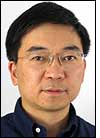Many companies that have deployed RFID systems in warehouses, distribution centers and retail stores receive tagged pallets and cases through portals positioned next to each other. But passive tags vary in sensitivity and other characteristics, and it’s often difficult for an interrogator to read all the tags—and only the tags—passing through its portal. A high-sensitivity interrogator may inadvertently read some tags passing through an adjacent portal, and reducing the sensitivity of the interrogator could result in some tags being missed entirely.
The underlying problem in these scenarios is that there’s no distance information between the tag and the reader antenna. Some advanced interrogators use received signal strength indicator (RSSI), a circuit that measures the strength of an incoming signal, to estimate the distance. But RSSI also determines many other factors, such as antenna gain, impedance matching and backscatter co-efficiency, so its distance measurement is not specific.
|
|
At the Auto-ID Lab at Fudan University in Shanghai, researchers are developing a distance-sensing reader technology based on time of flight. It measures the time it takes for a radio wave to travel from the reader antenna to the tag antenna and back to the reader. The distance from the reader to the tag is calculated based on the travel speed of a radio wave in the speed of light (approximately 300,000 kilometers per second).
But it’s not as easy as it sounds. It takes only 3 nanoseconds for the wave to travel 1 meter. So if we need to measure a distance of 10 centimeters, the accuracy of the time measurement should be 0.3 nanoseconds, which is difficult to reach using current technology. Another challenge is to differentiate the weak backscatter signal of a particular tag from the backscatter signal of other tags and the environment.
To address these problems, we use a modulation technique called direct-sequence spread spectrum. Instead of sending a continuous wave during reader-to-tag talk, the reader sends a pseudorandom sequence signal to the tag. The selected tag modulates the signal using backscatter. We measure the time between sending the sequence and receiving an echo signal from the tag. As the radio-wave speed is a constant, we can calculate the distance of the tag based on that delay. We can then set readers to interrogate only tags within this distance.
We recently tested a prototype of a distance-sensing RFID system and achieved distance measurement accuracy of about 0.5 meter. That’s not sufficient for a live application, but we’re working with the pseudorandom sequence to achieve 20-centimeter accuracy, which we believe we can reach this year. Commercial Gen 2 interrogators and tags with distance measurement capability could be available one or two years after that.
Hao Min is the research director of the Auto-ID Lab at Fudan University in Shanghai, China.


